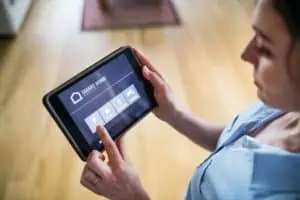Great home theater systems have great audio systems. And great audio systems create the powerful, surround sound burst that you expect from an entertainment experience. The only problem is, you probably have neighbors or at least family members who don’t necessarily want to hear action sequences resounding from the home theater room. The limitations of a home theater system, too often, are limitations of the walls and not limitations of the speakers.
So what’s a movie lover to do? Turn down the volume? Well, only as a last resort. Before your reach for that dial, start by doing your best to soundproof your home theater system.
Soundproof Drywall
The good news: sound is just waves. If you can block or absorb those waves without letting them reach the other side of the wall, then you’ve built a soundproof room. Drywall is the material that is used to form the visible walls of the structure. The drywall is not load bearing, and is the wall that receives the paint and texturing which faces into the room.
Since drywall is made to cover your home from floor to ceiling, it only makes sense that you could get a variety of drywall that is especially designed for soundproofing your space! Why purchase extra sound absorbing material when you could simply build it into the walls? Popular brands are QuietRock and National Gypsum’s SoundBreak. These brands are known for dampening the sound in a way that you could only achieve through 8 layers of traditional drywall. If all goes well, you’ll basically be placing an extra 8 walls between your sound and other people!
Traditional drywall is built from a sandwich of minerals between layers of paper. Since the drywall is actually pretty dense and thin, it’s a great conductor of vibrations. Soundproof drywall panels use additional inner layers of ceramics or viscoelastic to make them less likely to transmit soundwaves. These days, you can get soundproof drywall at most home improvement stores.
When you’re looking for soundproof drywall products, pay attention to the STC. The higher the STC numbers, or sound transmission class numbers, the better your wall will be at reducing sound.
Sound Dampening Panels
Acoustic panels, also known as soundproofing, sound absorbing, or sound dampening panels, are built to prevent sound from reaching your walls in the first place. If you’ve installed soundproof drywall, then you’ll block a large amount of the sound from reaching the outside. But true soundproofing also uses sound dampening panels to keep room in the room.
If you’ve seen the big foam panels, you may think that those are what recording studios use to absorb sound or block sound. But actually, you see foam panels in movies and in recording studios because they absorb the echo. The big egg crate type foam panels don’t actually reduce sound on the outside of the room, they simply maintain a clarity of sound inside the room. So sound absorbing products are actually just products that prevent sound from echoing around the room. This can be useful for home theaters where you want to prevent your movies from sounding like people are shouting in a big cave—but it won’t prevent your neighbors from hearing the entire soundtrack.
To block sound, you actually need to use solid objects to reflect it. You can’t put up foam to absorb sound. That’s not how sound works! Sponges don’t absorb sound, they simply muffle it as it passes through with little change in volume. If you want to soundproof your theater you need solid walls that block sound.
The best way of soundproofing a room is increasing the mass and density of the wall. Another great way to stop sound is to put up a second wall in front of the first, where the second wall doesn’t touch the first. If you use a bunch of layers of walls the sound won’t pass through.
Soundproof Curtains
Do they work? While heavier, dense materials will help block sound, they won’t totally prevent it from entering or exiting the room. Curtains are really useful for absorbing echo, but in this way they basically function the same way as acoustic foam on the walls.
However, unlike acoustic foam, they can be really dense and drape from the bottom to the top of a room. This allows them to add an extra layer of sound deflection to your walls. Soundproof drywall is still your best weapon against losing theater sound out of your house, but soundproof curtains can be a nice addition. Remember that “soundproof” is just a word that manufacturers can use to sell curtains, so look at the actual construction of the curtain. You want heavy, tightly woven curtains that can go all the way to the floor.
Soundproof Windows
Like drywall, you can purchase soundproof windows if your theater borders the outside of the house. Glass is usually thinner and more prone to vibrations than walls. If possible, removing the windows from the home theater might be for the best. Alternatively, you’ll want to buy studio-quality glass which can be a really expensive option. If you’re trying to keep costs down, opt for a window that is thicker. Then cover it with a soundproof curtain.
Will I Lose Sound Out the Ceiling?
Ceilings are usually not where you’ll lose sound since the roof of your house probably contains a ton of space between the initial ceiling and the top of the roof. All those layers of material do a great job of stopping sound from getting out.
Combination Solutions
For the perfect home theater, you’ll usually leverage a combination of different soundproofing solutions. Each one is a method for getting closer to 0 sound outside the theater. Unfortunately, all the foam and curtains in the world aren’t really going to do much to stop the transition of sound. Solid walls, and a lot of them, are the best way to reduce sound transmission. If you can install an extra sheet of drywall, that’s the best way to stop soundwaves from bouncing outside to bother family members not watching the movie.





